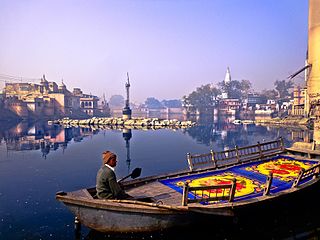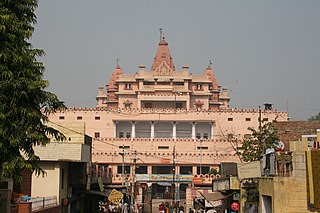
Mathura is a city and the administrative headquarters of Mathura district in the Indian state of Uttar Pradesh. It is located 57.6 kilometres (35.8 mi) north of Agra, and 146 kilometres (91 mi) south-east of Delhi; about 14.5 kilometres (9.0 mi) from the town of Vrindavan, and 22 kilometres (14 mi) from Govardhan. In ancient times, Mathura was an economic hub, located at the junction of important caravan routes. The 2011 Census of India estimated the population of Mathura at 441,894.

Bulandshahr, formerly Baran, is a city and a municipal board in Bulandshahr district in the state of Uttar Pradesh, India.

Mathura district is situated along the banks of the river Yamuna is a district of Uttar Pradesh state of north-central India. The historic city of Mathura is the district headquarters. Mathura district is home to many important sites associated with goddess Radha and Lord Krishna, who was born in Mathura and grew up in the nearby town of Vrindavan. Both cities are some of the most sacred sites in the Vaishnava tradition, making Mathura district an important Hindu pilgrimage centre.

Sacred Heart Catholic Church is a historic Catholic church building in downtown Dayton, Ohio, United States. Constructed at the end of the nineteenth century for a new parish, it closed in 1996, but was reopened in 2001 when a Vietnamese Catholic group began to use the church. This church building remains significant because of its grand architectural elements, which have led to its designation as a historic site.

Agrawal Jains are an Indian Jain community who originated from Agroha near Hisar, Haryana. In Sanskrit inscriptions and texts, the community is termed Agrotakanvaya.

The Council of State was the upper house of the legislature for British India created by the Government of India Act 1919 from the old Imperial Legislative Council, implementing the Montagu–Chelmsford Reforms. The Central Legislative Assembly was the lower house.

General elections were held in British India in 1934. The Indian National Congress emerged as the largest party in the Central Legislative Assembly.

General elections were held in British India between 28 October and late November 1926 to elect members of the Imperial Legislative Council and the Provincial Legislative Councils.

The Sacred Heart Cathedral is a cathedral of the Syro-Malabar Catholic rite in Rajkot. It is also known as Prem Mandir, meaning 'temple of love' in Hindi and Gujarati. The cathedral, which is dedicated to the Sacred Heart of Jesus, is situated near the bishop's house.

Kusum Sarovar is a sacred water reservoir with a historic sand monument in its backdrop. It is situated on the holy Govardhan Hill between Manasi Ganga and Radha Kund in Mathura district of Uttar Pradesh, India. Kusum Sarovar is considered one of the sacred spots that witnessed the pastimes of Hindu deities Radha and Krishna. It is also the place of Jat ruler Maharaja Suraj Mal's memorial chhatri. Kusum Sarovar has Narada Kund, where Bhakti Sutra verses were written by Narada and the Shri Radha Vana Bihari Temple in the vicinity.

Krishna Janmasthan Temple Complex is a group of Hindu temples situated in Mathura, Uttar Pradesh, India. There are three main temples inside the premises -- Keshavdevtemple which is dedicated to Krishna, Garbh Griha where Krishna is believed to be born in Dvapar Yuga and Bhagvata Bhavan where presiding deities are Radha Krishna.

Frederic Salmon Growse was a British civil servant of the Indian Civil Service (ICS), Hindi scholar, archaeologist and collector, who served in Mainpuri, Mathura, Bulandshahr and Fatehpur during British rule in India.
Sir John William Tyler FRCS (Edin.) CIE was a British surgeon and superintendent of the central prison in Agra, India, a position he held for 14 years. While superintendent he developed the prison as an important manufacturing centre for high-quality carpets. In 1886, he escorted 34 Indians, mostly prisoners, to the Colonial and Indian Exhibition of 1886 in London, where their craftsmanship in weaving carpets was displayed. At Queen Victoria's request, he recruited the servant Abdul Karim, later known as "the Munshi", who served her for the last 14 years of her life.

Garden Gate is a building in Bulandshahr, India, constructed as a gateway to the Bulandshahr public garden, also known as Moti Bagh. It leads to the Town Hall and was built in the late 19th century by Rao Umrao Singh of Kuchesar, who donated a significant fund for its construction. The project was encouraged by Frederic Growse, a British civil servant of the Indian Civil Service, who had been appointed collector of the region in 1878.

The Town Hall in Bulandshahr, India, was built by Muhammad Baquar Ali Khan at a cost of Rs. 30,000 in the late 19th century. The project was overseen by Frederic Growse, a British civil servant of the Indian Civil Service, who had been appointed collector of the region in 1878. It is situated in Moti Bagh, which was created as a public garden. The main approach was via the Garden Gate. It was built in 1883.

The Bathing Ghat in Bulandshahr is a stone platform with steps positioned between four domed towers on the banks of the Kali River in Bulandshahr, India. Its foundation stone was laid in 1878 under the supervision of British district magistrate and collector for the Indian Civil Service, Frederick Growse. It was completed in 1880.

Bulandshahr: Or, Sketches of an Indian District: Social, Historical and Architectural is an 1884 book written by Frederic Growse, a district magistrate and collector for the Indian Civil Service, about the district of Bulandshahr in the North-Western Provinces during the British rule in India. It was published by Medical Hall Press, Benares, and includes a description of Bulandshahr, an account of its history from antiquity to the 1857 rebellion, and of how the town was rebuilt under the supervision of Growse himself in the late 19th century.

Elliott Graham Colvin (1836–1883) was a British Indian Civil Service (ICS) Officer. He served in Mathura and Meerut during the Indian Rebellion of 1857 and later became Meerut's Commissioner. After his death, a gate was erected in his memory in Bulandshahr on the instructions of Frederic Growse.

All Saints Church is a church in Bulandshahr, India. It was constructed by the Public Works Department and completed in 1864. An adjacent dispensary, which later became a school, was added in 1867 and the caretaker's lodge was erected in 1883.
Kuar Lachman Singh, also known as Raja Lachhman Singh,, was an Indian deputy collector of the district of Bulandshahr, North-Western Provinces (NWP), India, and author of Historical and Statistical Memoir of Zila Bulandshahar (1874), commissioned by Lieutenant Governor of the NWP William Muir. He also produced a Hindi translation from Sanskrit of Shakuntala and Meghadūta.



























